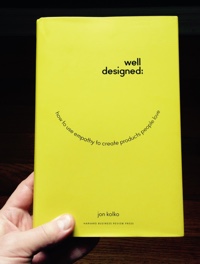It’s hard to imagine a world without the simplicity of the iPad. But just a few short years ago, the clocks on our VCRs blinked the unset time, reminding all of us consumers of the encroaching complexity of modern technology in our homes and lives. The landscape has shifted radically and quickly, and we have changed with it. Since we’re living in this landscape, it may seem as though we’ve collectively mastered the technology game, and that we just generally understand how to produce drop-dead simple products that tame the chaos of technological advancement.
But those of us who build products and services—those who are behind the facade of simplicity in the murky, muddy trenches of corporations, consultancies, and start-ups—are reminded of that complexity and confusion every day. Most of our product development processes are arcane and reflect outdated ways of thinking. The “product requirements document,” for example—a leftover artifact from the 1980s—still seems to find its way into product development meetings, and those same meetings seem to spin endlessly around arguments about features, alignment, and time-to-market.
As the market demands products that are simple to understand, robust in their technical capabilities, and most importantly, delightful to engage with, our legacy processes obviously don’t deliver. And with consumer expectations relentlessly rising, becoming overwhelmed with the complexity of feature matrices and specifications is easy. In this increasingly complicated and pressurized world, it’s hard enough delivering a useful product at all, much less one that someone really loves.
In the past decade, mostly in reaction to this anxiety and complexity, a number of methodologies have developed that purport to be fast, nimble, and quick. These methods reject documentation and deride linear process, swinging the pendulum in the direction of speed and results. Run loose and lean, it is said, in order to fail fast and succeed sooner. Yet these methods introduce a mess of their own, and as a result, consumers often end up with incomplete products that feel half-baked
While we can all take pride in shipping our products faster and more frequently, there is often real anxiety among both developers and marketers due to a lack of structure and process. “Agile? More like fragile,” we mutter. In cultures that have embraced many of these new methods, it can feel as though the bus is moving at tremendous speed, but no one seems to be driving.
Now consider the company Nest, one of a select crop of companies that represents a sea change in consumer product development, producing amazing new products with what appears to be ease and confidence. Nest has produced an important innovation in heating and cooling—which might be the least exciting market segment ever—and its new “learning” thermostat has been described as “sexy” and “beautiful.”
In another conservative industry—finance—we find a payment app like Square, which is “one of the easiest and most fluid ways I’ve ever paid for something.” Fast Company lauded it as “both a foolproof and attractive experience.”
In the hotel industry, Airbnb is turning hospitality on its side, with a simple, beautiful service based product that changes the way we think about travel. New products like these have launched in sectors as varied as health care, consumer electronics, financial management, and retail—and they have experienced large-scale growth and commercial success. Countless articles have described the brilliant user experience of products and services emerging from Apple, Nike, JetBlue, and Starbucks, and have correlated that experience with increases in profit.
The tiny, innovative Nest and its big and stodgy competitor Honeywell (130,000 employees) both have access to the same talent pools, to the same books and blogs, and to the same resources to help shape their products. So what was behind Google’s acquisition of Nest for $3.2 billion? Why are Nest’s products causing consumers and reviewers to use adjectives like “beautiful,” “drop-dead gorgeous,” “amazing,” and “revolutionary”? How do companies like this make it look so easy, while the rest of us can sometimes struggle to get even the simplest set of features shipped in an elegant and effective way?
Engagement is achieved by designing products that seem as though they have personality or even soul
What makes these companies unique is that their products are the result of a design process, and it is this process that has led to unprecedented media fascination and consumer adoption. Modern start-ups like Airbnb and large corporations like JetBlue or Starbucks have proven that industry disruption is possible not by focusing on adding features or merely getting people to buy more, but instead by focusing on providing deep, meaningful engagement to the people who use their products or services. This engagement is achieved by designing products that seem as though they have a personality or even a soul. These products feel less like manufactured artifacts and more like good friends.
A New Way of Developing Products
You may think of design as being about aesthetics or usability, and you may be familiar with design as it currently plays a role in your organization; typically, the role is fairly insignificant, often fuzzy, and undertaken by a few people who are deemed “creative.” While designers and developers may be asked to participate in brainstorming activities, their job is frequently prescribed for them: they are handed a specification and told to satisfy requirements that someone else has already defined. I’ve seen talented individual contributors scratching their heads about these requirements, because they are left without a strategic view of how these choices support larger business decisions. They don’t understand why product decisions were made in the first place, and they question the value of particular decisions or an entire strategic approach.
While design has common connotations of aesthetics or ease of use, an important goal of Well Designed is to get you to think of design less as a way of making things look a certain way, and more as a way of getting things done. The design process I lay out leads to innovation and emotionally engaging new products and services. This process is centered around empathy and is built on deep research with real people in their natural environments. It generates meaningful insights into human behavior and leverages these insights through a structured form of exploration. It is iterative, using visual thinking to explore potential possibilities for how the future will look. And it recognizes and celebrates creativity in all people involved in product development, not just the people who wear the black turtlenecks or horn-rimmed glasses.
In fact, with the ongoing rise of digital technology and the general empowerment it provides to people in all kinds of enterprises, this design process and way of thinking applies to almost anyone involved in creating and providing products or services to customers, not just those already involved in product development or brand management. In some of the companies mentioned, the word design is absent from job titles and process manifestos. But when you explore what the people at these companies are actually doing, it becomes clear that they are using the same methods and techniques as designers, as part of a comprehensive way of thinking about people and human behavior. In organizations that use this design thinking and process, product owners establish deep empathy with a community of consumers in order to identify problems to solve. They leverage a distinctive way of thinking in order to infer solutions to those problems that will have meaningful emotional appeal, and they align around a vision and a goal using shared visual artifacts.
At the core of design-focused product development is emotional engagement—the deep feelings a person forms about a product while using it. People tend to personify products—especially, increasingly, digital products—assigning them human characteristics and relating to them on an emotional, human level. To understand and design for this emotional appeal, it’s critical not only to understand people, but to truly empathize with them in order to feel what they feel.
How can you can gain such genuine empathy? The only way is by spending time with people and getting to know them on a personal and intimate level, doing your best to see what they see and experience what they experience. This empathetic approach is designed specifically to generate insights, with an “insight” defined as a hypothesized guess about human behavior, but framed as a definitive truth. These insights hold the keys to innovation, and the clear, flexible design process described in this book provides the engine for developing insights into products people love, over and over again.
Put simply, in Well Designed, you’ll learn how to apply a powerful and repeatable design process to product management; when used effectively, this process will identify critical insights about people and will translate these insights into meaningful products.
Here are the four key elements of the process:
- Determine a product-market fit, by seeking signals from communities of users.
- Identify behavioral insights, by conducting ethnographic research.
- Sketch a product strategy, by synthesizing complex research data into simple insights.
- Polish the product details, using visual representations to simplify complex ideas.
This is an end-to-end process with specific, proven methods and techniques. Through successive chapters featuring instructive examples and lessons, as well as interviews with product managers for some of the world’s best-known products and services, you’ll learn how to shape and employ a process of design to develop your own engaging products. Specifically, you’ll learn:
- That empathy is the key to building meaningful products, and empathy can be taught and learned.
- How to work through the complexity of human and qualitative research in order to arrive at the simplicity of a new offering.
- That a product’s personality, which is critical to its success, can be established through a rigorous process of ideation.
- How to sketch visual representations that help communicate a vision of the future to a small team of cofounders or a large group of stakeholders.
To learn more about Kolko’s end-to-end design process, pick up a copy of Well Designed from Harvard Business Review Press.
Illustration of VCR courtesy Shutterstock.








